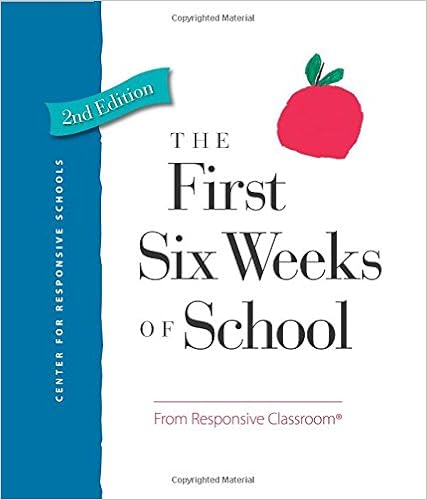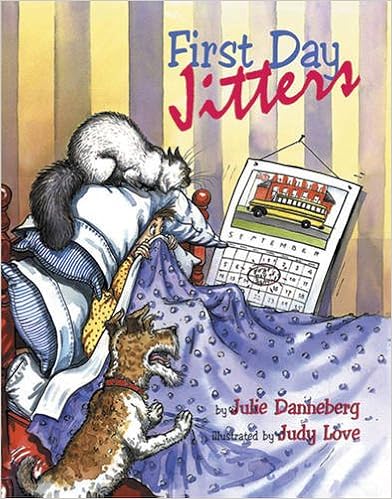I am writing a very short post today, but I wanted to talk about the first day of school. For the past few years, I have done things pretty similarly with minor changes in my plans due to a different schedule each year. If you're in the same boat I am in right now, you are trying to get your lesson plans for your first week finished. I highly recommend using this book to help you:
This book was designed to get you started smoothly. I say this all of the time, but I really believe it: You must go slow to go fast. My Responsive Classroom mentor said this during my first training, and I couldn't agree more now. Starting off slowly and smoothly lets you get SO MUCH MORE done during the year. The book has everything from goals you might want to meet each week to sample schedules for many different grade levels. I use this book religiously at the start of every year. It helps me get off to a great start! Each year, I pick up something different from it. If you're interested, click the picture above to be taken right to amazon to order it. If you have Amazon Prime, you'll have it in only two days! (I looooooove Amazon Prime.)
My first day of school is Wednesday, so I am only planning for 3 days right now. Here are a few highlights of my first day that you might want to try:
Scavenger hunt
In my school, the kids enter the classroom on the first day at all different times. My kids start arriving at around 8:45 and can get in as late as 9:20ish on the first day. I need something to do to keep the kids occupied when they arrive. I tell the kids to read the directions on our smart board after saying hello. Basically, it tells them to find their desk, put their backpack down, read the morning message, and get started on a scavenger hunt. The scavenger hunt is fabulous! It sets the tone for cooperative learning and helps you build your community right away.
The only rule of the scavenger hunt is that you can only ask one question for each person at a time. So, if I ask a student named David one of the questions on my scavenger hunt, I must ask someone else about another item before I can ask David another question. If someone answers yes to a question, they sign their name next to the item they answered. There are questions like "Who had toast for breakfast?" and "Who went to a different school last year?" I love the way that is structured. It makes the kid from another school a really important part of the game and makes them feel special when they're likely really nervous. Third graders are really up for this challenge. Last year I tried this for the first time, after being used to first graders, and my jaw was pretty much on the floor watching my class in awe. They were so much more assertive than I would have been as a kid! They did a lovely job with this. Of course, once in a while a few students break the only rule of the game by asking someone more than one question at a time, but that doesn't really matter. The point is that it builds community.
Morning Meeting
Of course, I am a huge fan of Morning Meetings, and I have them every single day in my room. However, on the first day I do things differently. I like to introduce Morning Meeting by first talking about the concept of meetings. After we talk about what meetings are and why they are held, I tell the kids we will be having meetings every day in our room. I introduce the rules of Morning Meeting (these are separate than class rules, which we make together later on in the first weeks of school) next. They are a few short rules (like, "Keep empty hands at meeting" and "Listen to the person speaking") that outline what we need for discussions to run smoothly.
Next, we have a greeting. I pick one that is low-risk at first, and we gradually build risk as the kids get to know each other. I do "1, 2, 3, POP" on the first day. The kids sit in a circle and count off by 4's. The person who would say 4 says, "Pop" instead and stands up. Then I have them say their name, their age, and their birthday. Easy and quick for the first day. Then the person next to them starts counting again. We do this until everyone has had a chance to "pop." This is lower-risk emotionally for students. They are not forced to shake hands with someone they don't know or do things they are uncomfortable with. I think this is really important.
Last we have our Morning Message. Now, the typical structure of a meeting is: 1. Greeting, 2. Share, 3. Activity, 4. Morning Message. I gradually introduce morning meeting. After these two components are easy for students (usually it only takes a day or two) I introduce activities. Next I introduce sharing. Last year I was doing all 4 components of a Morning Meeting by the third day of school. Each class will have different needs.
Read Aloud
Reading aloud is so much fun for the kids, and it is a nice way for kids to start doing academic work without feeling like they're taking too many academic or emotional risks too soon. Every year I read the book First Day Jitters to my students. They always love it. So do I!
Click the link above if you'd like to purchase the book. Basically the book is about how a girl named Sarah is nervous for her first day of school. It's a REALLY cute book with a fun twist, but I won't ruin it for you if you haven't read it yet.
Guided Discovery
This is an important piece of my first day. I do not introduce any materials to students without doing a guided discovery first. Guided discovery is similar to interactive modeling, except it is used when there are many ways to do something. For instance, there may be one way to walk with scissors safely, but there are many ways to use paint. In short, here are the steps of a guided discovery:
1. Introduce the material(s) you'll be exploring. (Many teachers like to add the element of surprise here by putting items in a bag and having students guess about what the object(s) are. Not necessary, but sometimes fun!)
2. Generate ideas. I ask the students what they can do with the materials. We brainstorm ideas. Sometimes we right them down on chart paper or a dry-erase board. Then I have some students quickly model some of the ideas. Sometimes, especially in younger grades, teachers will have everyone model an idea together.
3. Explore. The kids get some time to experiment with the materials on their own.
4. Share. The kids can share out their work with the class. Sometimes it's with a partner, sometimes it's quickly and at-a-glance with the whole group, sometimes it's a museum walk.
5. Procedural Pieces. This is where you get a chance to tell important things about an item. Maybe you will model how to clean it up.
On the first day of school, I do a guided discovery with students with the materials in their table caddies. These caddies include pencils, erasers, post-it notes, colored pencils, markers, and crayons. I give them paper and let them do what their hearts desire. It may sound silly, but it's really important to do. You also have something student-created to hang up in your room by the first day.
Partner Tag
This is a favorite of my students. We go outside and play tag together, but it's not just any tag--it's partner tag! Everyone is assigned a partner, and the only person they can tag is their partner. Basically, it's a bunch of tag games being played at once. To play partner tag, you must walk. It makes it a safe indoor game if there is enough space and your students can handle it. I will often take kids to our small gym on indoor recess games for 2 minutes of partner tag. It makes all the difference in the world!
First, I model safe tagging with the kids and give them a chance to practice. Next, I model the game. If I'm "it" first, I cover my eyes and count out loud to three. Then I can start walking after my partner. I tag them safely. Then my partner repeats. When you give guidelines for space kids can use, they can get really creative with walking around other classmates to avoid being tagged. This game always leads to lots of giggling, even with adults. I highly recommend this game. But make sure to model how to be safe and make sure to partner students up so they know who they are playing with. You might need to tell them who will be "it" first as well.
Well, those are my big first day activities. We do a lot of interactive modeling, but I feel these are the best parts of my day. They are the non-negotiable activities that happen every year, regardless of my schedule. It's so much fun!
My next post will be my classroom reveal. It's so close to being finished! What do you do on your first day? Are there special activities you love? Do you have a special read aloud you like to read? Make sure to comment below so other teachers can benefit from your awesome ideas! :)



This was a great way of going over first day of school & what follows. I can't wait to check out that book. Great post!!
ReplyDeleteThanks, Bekka! :)
Delete